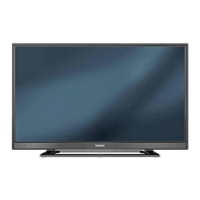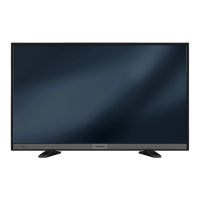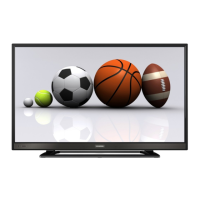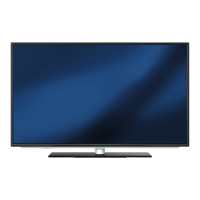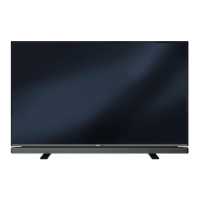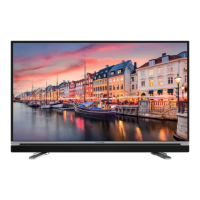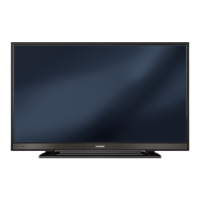
Do you have a question about the Grundig 48 VLE 5421 BG and is the answer not in the manual?
| Smart modes | Hotel |
|---|---|
| Screen shape | Flat |
| Response time | - ms |
| Display diagonal | 48 \ |
| Display brightness | - cd/m² |
| Native aspect ratio | 16:9 |
| Native refresh rate | 200 Hz |
| LED backlighting type | Edge-LED |
| Display diagonal (metric) | 121 cm |
| Supported graphics resolutions | 1920 x 1080 (HD 1080) |
| Motion interpolation technology | PPR (Picture Perfection Rate) |
| 3D | No |
| Annual energy consumption | 127 kWh |
| Tuner type | Analog & digital |
| Analog signal format system | - |
| Digital signal format system | DVB-C, DVB-S, DVB-T |
| Audio system | SRS TruSurround |
| RMS rated power | 40 W |
| Number of speakers | 2 |
| HDMI ports quantity | 3 |
| DVI-D ports quantity | 0 |
| SCART ports quantity | 1 |
| USB 2.0 ports quantity | USB 2.0 ports have a data transmission speed of 480 Mbps, and are backwards compatible with USB 1.1 ports. You can connect all kinds of peripheral devices to them. |
| Audio formats supported | AAC, M4A, WMA |
| Image formats supported | BMP, JPG, PNG |
| Video formats supported | AVI, DAT, DIVX, MKV, MOV, MP4, MPG, TRP, TS, VOB |
| Product color | Black |
| Panel mounting interface | 400 x 200 mm |
| AC input voltage | 220 - 240 V |
| AC input frequency | 50 - 60 Hz |
| Power consumption (max) | 87 W |
| Power consumption (standby) | 0.5 W |
| Package depth | 145 mm |
| Package width | 1160 mm |
| Package height | 790 mm |
| Package weight | 12250 g |
| Depth (with stand) | 220 mm |
|---|---|
| Height (with stand) | 683 mm |
| Depth (without stand) | 45 mm |
| Width (without stand) | 1086 mm |
| Height (without stand) | 652 mm |
| Weight (without stand) | 9250 g |
Instructions for TV setup and safety warnings for operation and placement.
Warnings on electrical connections, power cords, and proper battery handling/disposal.
Requirements for receiving digital TV signals via satellite, terrestrial, and cable.
Step-by-step guide for connecting the TV to antenna sources and the power supply.
Diagram and explanation of all input/output sockets on the TV.
Details the primary functions of the remote control buttons.
Guides through the first-time setup process for channels.
How to set up basic preferences like language, country, and power-saving modes.
Instructions for setting up satellite channels, including easy and advanced installation.
Detailed steps for advanced satellite channel tuning and configuration.
Steps for tuning digital terrestrial TV channels using an antenna.
Instructions for tuning digital cable TV channels.
Adjusting picture parameters like brightness, contrast, sharpness, and color.
Adjusting audio parameters like volume, balance, sound type, and SRS settings.
How to turn the TV on, off, and switch to standby mode.
Methods for selecting TV channels, directly, step-by-step, or via the channel list.
How to control the TV's audio volume.
Adjusting aspect ratios like 16:9, 4:3, LetterBox, Panorama.
Overview of recording capabilities, prerequisites, and limitations for digital TV.
Restrictions that may affect recording/playback due to broadcaster policies or media protection.
Navigating to the USB Recording menu and its initial options.
Using the time shift function to pause and resume live TV.
General information about recording digital TV programs onto external media.
Simple method for recording a selected TV channel.
Recording a program directly from the TV's channel list.
Scheduling recordings using the Electronic TV Guide.
Manually scheduling recordings by entering program details.
General information on playing back recorded content from external media.
Accessing and selecting recorded programs.
Instructions for connecting USB storage devices to the TV.
General controls for playing media files (video, audio, picture).
Selecting primary and secondary audio languages for digital broadcasts.
Managing subtitle display and language preferences.
Setting access levels for age-restricted content.
Blocking specific TV channels using a PIN code.
Checking for and installing TV software updates.
Resetting the TV to factory defaults, erasing custom settings.
Finding and enabling connected devices that support DIGI LINK.
Connecting devices via HDMI for digital signals.
Connecting common AV devices.
How to connect a computer to the TV for use as a monitor.
Adjusting picture settings and configuration for PC input.
Performing an automatic scan for new satellite channels.
Manually tuning satellite channels using specific parameters.
Configuring LNB settings for satellite reception (SCR, LNB type, power).
Configuring the TV to control a motorised satellite antenna.
Fine-tuning antenna alignment and saving positions for DiSEqC 1.2 systems.
Performing an automatic scan for cable TV channels.
Manually tuning cable TV channels by entering frequency.
Performing an automatic scan for digital terrestrial TV channels.
Manually tuning digital terrestrial TV channels by channel number.
Checking signal strength and quality for digital channels.
Common problems, their possible causes, and recommended solutions for TV operation.
